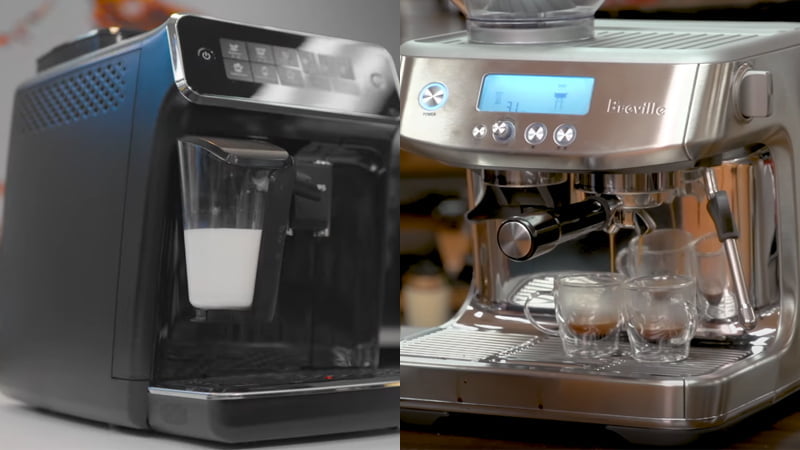Philips 3200 vs Breville Barista Pro: Which one is better? To my mind, the short answer is the first one.
The Philips 3200 doesn’t deliver the most exquisite-tasting espresso, and its automatic milk frothing system isn’t quite suitable for latte art, but it compensates in other areas. Its lighter weight, ability to fit large cups, and presence of a detachable brew unit for in-depth cleaning make it a winner.
The Breville Barista Pro, on the other hand, can produce delicious, full-bodied espressos. Moreover, with some hands-on experience with its steam wand, you can effortlessly achieve consistently dense foam perfect for cappuccinos and smoothly steamed milk ideal for lattes.
Philips 3200 Vs Breville Barista Pro: Comparison Chart




Last update on 2025-07-02 / Affiliate links / Images from Amazon Product Advertising API
Philips 3200 Vs Breville Barista Pro: Differences
The Philips 3200 wins 3-1 against the Breville Barista Pro, but that is just the tip of the iceberg. Keep reading for more valuable information.
Coffee Flavuor
Winner: Breville Barista Pro
Built-in Grinder
Grinding stands as the initial phase, kicking off the bean-to-cup process. Most espresso machines, including the Philips 3200 vs Breville Barista Pro, have a built-in grinder, saving you the hassle and cost of buying a standalone one. The Philips 3200 features a ceramic flat burr grinder, while the Breville Barista Pro sports an integrated steel conical burr grinder.
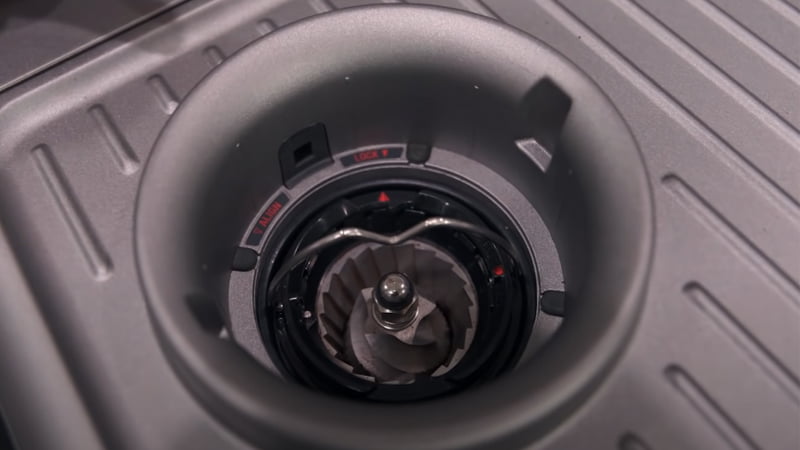
One major advantage that a ceramic grinder has over a steel one is its ability to remain cool during the grinding process. So it avoids scorching the coffee grounds and ruining their fragile aroma. Consequently, you are rewarded with an espresso with the fullest possible aroma and flavor.
Moreover, the ceramic grinder enjoys a reputation for quiet operation. I found the noise level of the Philips 3200 not annoying at all and quieter than most espresso machines I’ve ever touched. Many people have complained that this one is noisy, which makes me question their definition of the term “quiet.” As for the Barista Pro, if you’re going to use it in the wee hours of the morning, be prepared for a symphony of grumbles and complaints.
Let’s talk about the grind settings on these machines. I don’t remember how many times higher-end models from Jura let me down a bit since they typically only offer about 5-6 settings, and sometimes I find my ideal flavor stuck between two grind sizes. But this issue is non-existent with these machines: the Philips 3200 carries 12 grind settings, and the Breville Barista Pro stands out with its impressive 30 settings, from super fine to coarse grind. There are many settings for you to trial and error to find the right fineness of the grounds for your recipe.
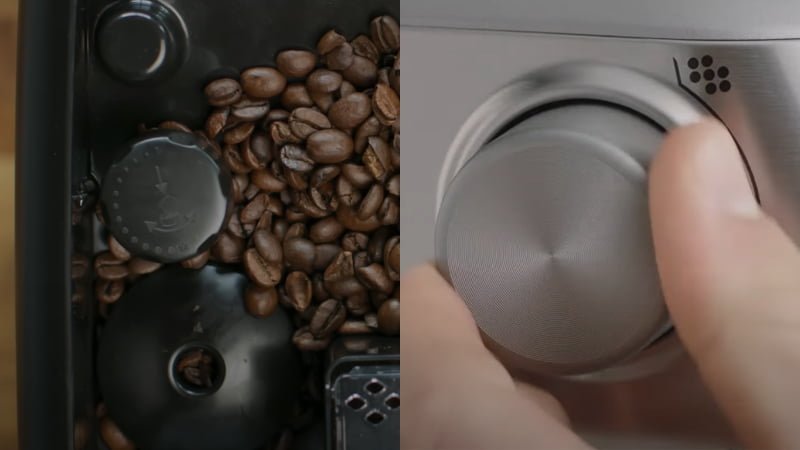
Remember not to switch between grind sizes when the grinder is off. Moreover, Philips recommends refraining from changing the grinder settings during the first 100 to 150 espresso cups. Although my own impatience didn’t lead to any problems, it’s always best to adhere to the manufacturer’s recommendations.
The Barista Pro comes out of the box with a 54 mm stainless steel portafilter and four filter baskets, including pressurized and non-pressurized options for single and double shots.
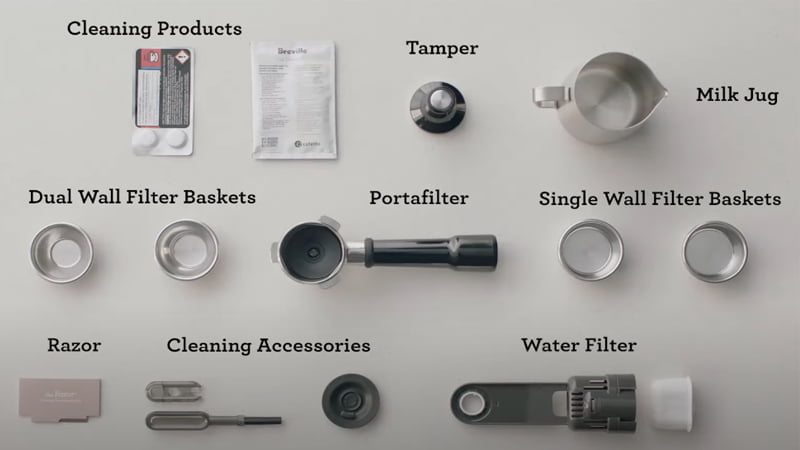
A non-pressurized basket requires a precise grind size for the water passing through the coffee puck to pull gorgeous and flavorful espresso shots. If the grind size is inaccurate, it can lead to under-extraction or over-extraction of the coffee, resulting in sour or bitter-tasting espresso.
Meanwhile, a pressurized basket can create artificial pressure during extraction, compensating for inconsistencies in grind size. Thanks to that, beginners, even with an unpolished grinding technique, can manage to brew a decent espresso shot. It is also an ideal option to use with pre-ground coffee.
I was so happy to get a robust stainless steel tamper instead of the cheap-feeling plastic one that comes with many Gaggia machines.
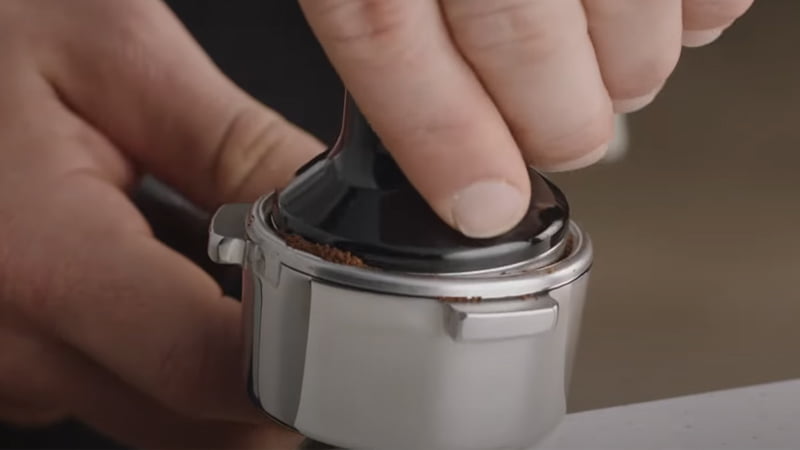
Heating System
Both are single-boiler machines, meaning they can brew espresso and prepare milk foam simultaneously. Still, that’s not a bad thing for these machines since they can quickly heat up to the right temperature.
Thermoblock technology allows the Philips 3200 to reach the proper temperature in about 20 seconds, while the Breville Barista Pro’s thermojet heating system can heat up in just 3 seconds and switch between brewing coffee and steaming milk in under 10 seconds. So your espresso doesn’t have enough time to cool down before the milk foam is ready. You can also further reduce heat loss by putting your cups on top of the machine (called a cup warmer) to preheat them.
The Barista Pro, no doubt, heats up very rapidly, but the portafilter needs to be preheated separately for precise espresso extraction. My recommendation is to run a blank shot (a shot without any ground coffee in the portafilter) and wipe the filter basket before grinding.
Brewing System
The pre-infusion process feels like a standard feature in most modern espresso machines, including both the Philips 3200 vs Breville Barista Pro. Why? It is the key to achieving a better-tasting espresso shot.
Pre-infusion involves saturating the coffee grounds with a small amount of hot water before applying full pressure for extraction. It allows the coffee grounds to bloom, reducing the risk of channeling and enhancing the overall quality of the espresso.
It’s worth noting that the Breville Barista Pro allows you to control the length of the pre-infusion stage, while the Philips 3200 doesn’t. So if you are unsatisfied with the factory-set interval, you can step in and fine-tune it to suit your preferences better.
Then, both extract espresso at 15 bars of pressure, while the standard pressure for espresso extraction is just 9 bars. For those unfamiliar, unlike drip coffee makers that rely on gravity, espresso machines use pressure for extraction.
In my testing, the Breville Barista Pro produced rich, aromatic espresso shots bursting with flavor that tasted similar to something you’d get at your local coffee house. On the flip side, the espresso that came out from the Philips 3200 was pretty weak, topped with a really thin crema. I surmise that the crux of the issue lies in the extraction being faster than it should be: it takes only 20 seconds, while espresso shots typically take 30 seconds.
Milk Frothing System
This is the biggest difference between the Philips 3200 vs Breville Barista Pro. The Philips 3200 has a fully automatic milk frother, enabling you to produce milk foam and steamed milk with a simple button press. In contrast, the Breville Barista Pro utilizes a manual steam wand, which necessitates a bit of a learning curve.
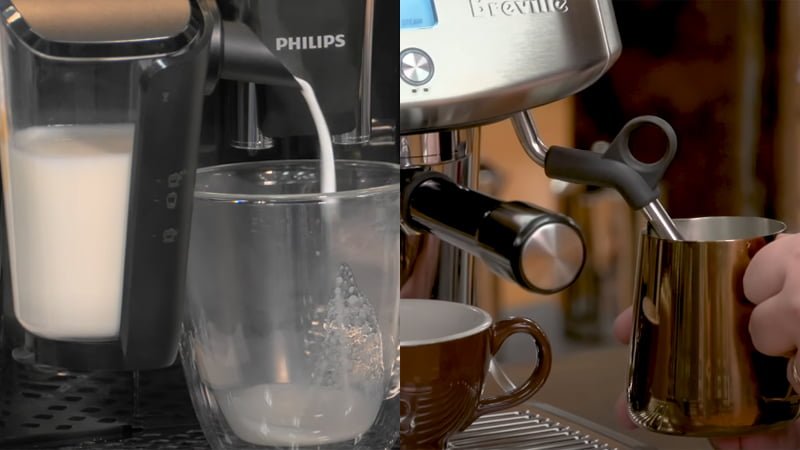
As a novice, you might find it hard to resist the allure of brewing a milk-based beverage with just a single touch. But with perseverance, you’ll soon find the steam wand a gem since it gives you greater control over the milk’s texture and temperature. Also, it can help you craft latte art that an automated system never achieves. That said, you will have an extra skill to impress your loved ones and make every coffee moment feel special!
Let’s kick things off with the Philips 3200’s automated frothing milk system (also known as the LatteGo system). It is worth noting that there’s another variant of the Philips 3200 that sports a traditional frothing wand and is slightly more affordable.
The clever LatteGo system comprises three components: a transparent milk pitcher, a black plastic clip, and a top cover for the pitcher. The milk carafe can be refrigerated when not in use and washed under the tap for a deep clean. Before freezing milk, ensure the container is firmly clipped in to avoid a potential mess. The top lid simply rests on the pitcher, and I wish this one had a hinge to secure it.
Making milk foam with the LatteGo system is a breeze: fill the pitcher with milk, clip it to the machine, choose the milk froth quantity, and the machine handles the rest. The milk gets mixed with air at a high velocity in the frothing chamber, and then the machine seamlessly dispenses the milk foam into your cup.
On the flip side, the Breville Barista Pro features a 4-hole steam wand rather than the standard 1-hole one for home espresso machines. It delivers a more even steam distribution and better aeration, resulting in better microfoam milk. The wand has a rubber grip and can rotate freely, simplifying the positioning of the milk pitcher.
Fill the included metal jug with your cold milk, dip the wand in the milk, switch on the steam dial, and you will see the milk spin clockwise. Just keep going until you find the pitcher is too hot to hold. Mastering latte art is not an overnight job, so you’ll need a few attempts and perhaps a few errors, to ultimately get it right.
My test showed that the Philips 3200 produced consistently thick foam that is good for making a nice cappuccino instead of smooth, silky steamed milk for lattes. It is impossible to adjust the foam texture – the only aspect you can tweak is the quantity. Conversely, I found the Breville Barista Pro to excel at both – I could whip up a pretty awesome cappuccino and latte. So, if you aspire to practice your latte art skills, the Breville Barista Pro is, no doubt, your best bet.
Design & Usability
Winner: Philips 3200
Dimensions, Footprint, & Weight
| Philips 3200 | Breville Barista Pro | |
|---|---|---|
| Dimensions | 9.7 x 14.6 x 17 inches | 13.5 x 13.9 x 16 inches |
| Weight | 17.7 lbs | 20 lbs |
The Philips 3200 features a simple but classy design with a sleek black casing and attractive chrome accents, giving it a luxurious aesthetic. This one is made mostly of plastic, but it emanates a sense of sturdiness rather than fragility. The entire operation is controlled via a large, non-touch control panel situated on top.
The Breville Barista Pro, on the other hand, appears captivating and robust with an all-metal exterior, but don’t be deceived by its outward appearance – this model is mostly made of plastic as well. Its text-only LCD screen is there just to make navigating the machine easy instead of giving it the modern, science-fiction feel found in some high-end counterparts.
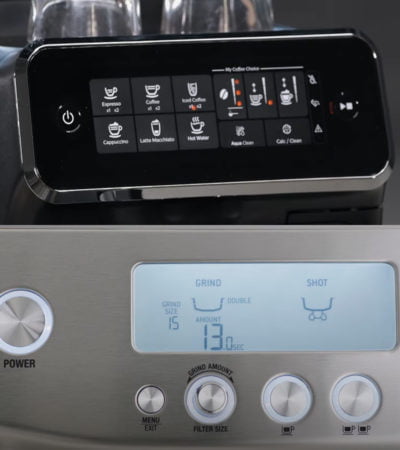
These kitchen appliances have a compact construction and will fit nicely on most kitchen countertops. The only problem is that they are quite heavy, so you might have to flex your muscles and break a sweat to get them perfectly positioned.
Pre-programmed Coffee Options
| Philips 3200 | Breville Barista Pro |
|---|---|
| Espresso Black Coffee Americano Cappuccino Latte Macchiato Hot Water | Espresso Hot Water |
The Philips 3200 facilitates the preparation of several milk-based drinks with one touch, whereas the Barista Pro requires you to roll up your sleeves and do it yourself with its built-in steam wand.
I love their hot water function. Instead of waiting tens of minutes for a traditional kettle to boil, you can quickly get hot water for brewing tea in under one minute. But while the Breville Barista Pro has a separate hot water dispenser, the Philips 3200 requires removing the milk carafe to use this function, which may be slightly bothersome for some.
Regarding customization, the Philips 3200 offers 3 levels of coffee strength, brew temperatures, shot length, and volume of milk. The Breville Barista Pro has up to 5 brew temperatures and offers a wider range of coffee volume and shot length. Any alterations will be saved as defaults until further changes are made.
Pre-ground coffee isn’t really used often, but it is a lifesaver in some emergencies, such as when you run out of coffee beans or your guest has a caffeine intolerance. The Philips 3200 has a bypass dose chute for that purpose. As for the Breville Barista Pro, just put your pre-ground coffee into the pressurized filter basket and pull a shot of decaf.
Spout & Cup Clearance
| Philips 3200 | Breville Barista Pro | |
|---|---|---|
| Spout Type | Dual | Dual |
| Cup Clearance | 3.3–6.9 inches | 4 inches |
The Philips 3200’s coffee dispensing spout can be lifted up to nearly 7 inches to fit those jumbo-sized mugs. It can also move down too low to prevent unwanted splashes and ensure the crema looks as good as possible. The Barista Pro doesn’t offer adjustable cup clearance, but it should be adequate unless you attempt to use a travel mug or thermos. If you really need extra space, just pull out its drip tray as a reluctant solution.
Both have a double shot function, preparing two cups of espresso simultaneously. This is really a boon, as no one enjoys forming a queue during those rush mornings just for their much-needed caffeine drink, right?
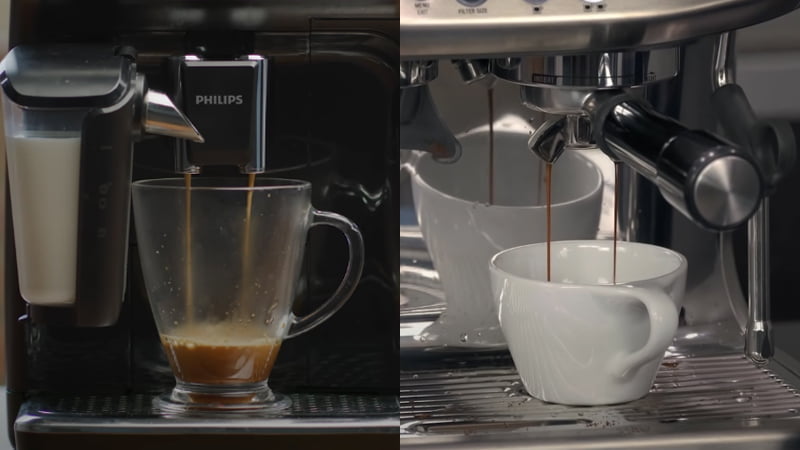
The milk spout of the Philips 3200’s LatteGo system is a bit too high, especially if you want to prepare smaller drinks like a cappuccino. The milk has to descend a considerable distance before reaching your cup. So if you miscalculate your cup position, you can end up with a white mess on your countertop, resulting in extra cleaning.
Water Reservoir & Bean Hopper
| Philips 3200 | Breville Barista Pro | |
|---|---|---|
| Water Reservoir | 1.8 liter | 2 liter |
| Bean Hopper | 0.28 liter | 0.24 liter |
Unless you place these espresso machines in busy settings or high-traffic areas, they don’t need to be refilled too often. For home use, one refill per day is more than enough. The Barista Pro’s reservoir is positioned at the back, making it somewhat harder to access than the front-located tank of the Philips 3200, particularly if the machine is nestled under a fixture such as kitchen cabinets.
Oh, you should know their water reservoirs are designed to accommodate the included water filters. The use of the filter is optional, and it requires a monthly charge. So before you settle on whether to use it, let’s delve into its function.
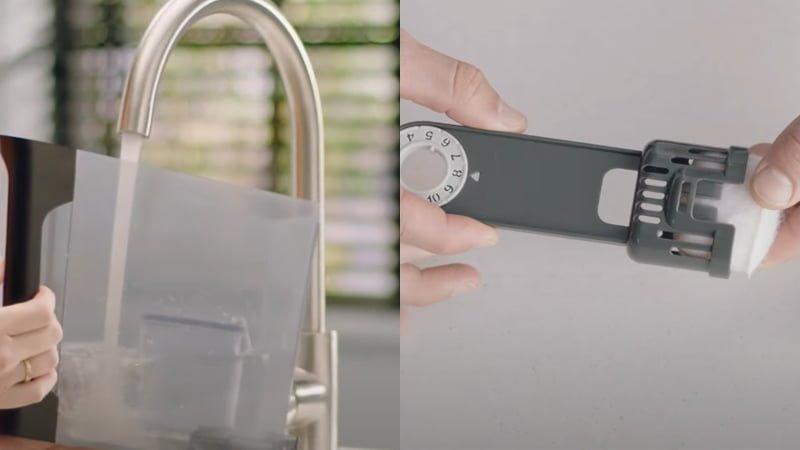
Unless you use bottled or distilled water, your input water contains some impurities. During the heating process, these impurities can cause scaling (a familiar issue if you’ve ever used a conventional kettle). Over time, this can degrade the machine’s performance, necessitate regular descaling, and negatively affect the quality of your espresso’s flavor.
Their bean hoppers are top loading, and you can leave leftover beans there for a long time without worrying about a quick loss of their aromatic quality. The linchpin is that their lids have a rubber seal that effectively blocks out air and sunlight, ensuring the beans remain untouched when closed.
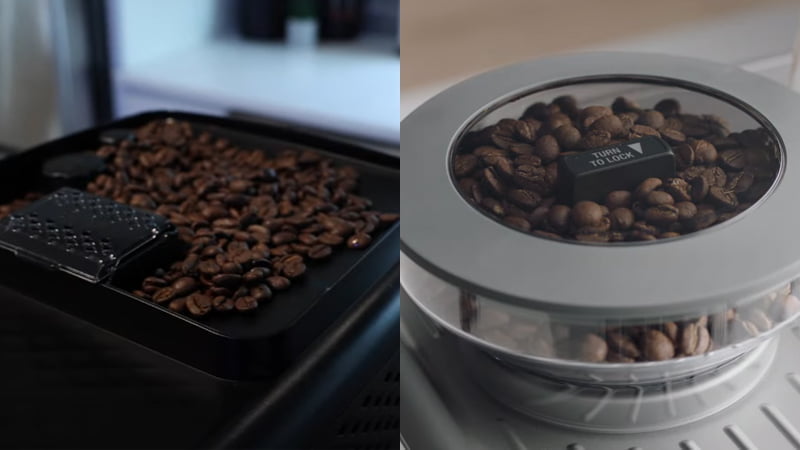
Cleaning & Maintenance
Winner: Philips 3200
Now I’ll talk about the elephant in the room – cleaning, and maintenance of the machine. I know this part is not as enjoyable as sipping on a heavenly espresso, but it plays a crucial role in maintaining the machine’s longevity and optimal operation.
Speaking of descaling, the machine will tell you when it needs to be descaled. The process is automatic, and all you need to do is use the recommended descaling solution to remove the build-up limescale. And if you use the included filter or pre-filtered water, the machine could potentially stretch for years without demanding a descale.
Once you’re done using the Breville Barista Pro, be sure to purge steam through its wand and subsequently wipe it clean using a damp rag. For the LatteGo milk system of the Philips 3200, a simple rinse of the container and lid under the faucet or a dishwasher cycle will suffice for an extensive clean-up.
Regarding day-to-day maintenance tasks, there is little to do: drain the drip tray, empty the coffee grounds basket, wipe down the machine’s casing, clean the portafilter under the tap, etc. I give the winning ticket to the Philips 3200 this round since its brew group is removable – Although it demands manual cleaning and lubrication, in my view, this approach is more trustworthy than a purely automatic process.
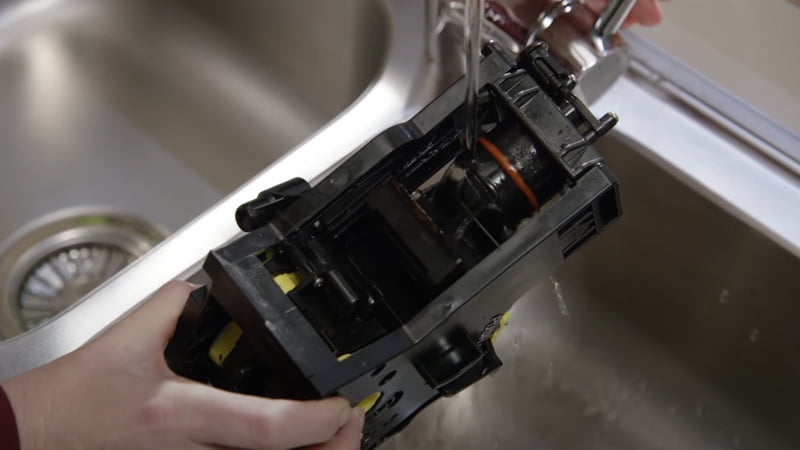
Utilities & Other Features
Winner: Philips 3200
Auto Off
Both come with an automatic shut-off function to conserve energy. But while the Breville Barista Pro will automatically turn off after 30 minutes of inactivity, the Philips 3200 allows for configuring the stand-by interval to 15, 30, 60, or 180 minutes.
Quick Rundown Of Philips 3200
- 5 AROMATIC COFFEES: Enjoy your favorite coffees for special moments. Whether you crave an espresso, coffee, americano, cappuccino or a latte macchiato, your fully automatic espresso machine delivers a perfect in-cup result with no hassle and in no time.
- INTUITIVE TOUCH DISPLAY: The irresistible taste and aroma of coffee from fresh beans is just one touch away. Our intuitive touch display allows you to easily select your favorite coffee.
- PERFECT TEMPERATURE AND AROMA: The Aroma Extract system intelligently strikes the optimum balance between brewing temperature and aroma extraction.
- 2 PARTS, NO TUBES MILK SYSTEM: Our 2 parts milk system has no tubes or hidden parts and can be cleaned in as little as 15 seconds under tap or in the dishwasher.
- AQUACLEAN FILTER: By changing the filter after being prompted by the machine, you will not need to descale your machine for up to 5,000 cups, while enjoying clear and purified water.
Last update on 2025-07-02 / Affiliate links / Images from Amazon Product Advertising API
Quick Rundown Of Breville Barista Pro
- The Breville Barista Pro delivers third wave specialty coffee at home using the 4 keys formula and is part of the Barista Series that offers all in one espresso machines with integrated grinder to go from beans to espresso in under one minute
- DOSE CONTROL GRINDING: With a single touch, the integrated precision conical burr grinder with dose control delivers the right amount of coffee on demand, for maximum flavor
- OPTIMAL WATER PRESSURE: Low pressure pre-infusion gradually increases pressure at the start and helps ensure all the flavors are drawn out evenly during the extraction for a balanced tasting cup
- FASTER HEAT UP TIME: Innovative ThermoJet heating system achieves the optimum extraction temperature in 3 seconds with the instantaneous transition from espresso to steam
- PRECISE ESPRESSO EXTRACTION: Digital temperature control (PID) delivers water at the right temperature +/- 2°C, ensuring optimal espresso extraction
Last update on 2025-07-02 / Affiliate links / Images from Amazon Product Advertising API
Product Videos
| 1 |
Related Articles to Breville Barista Pro
- Breville Barista Pro Vs Rancilio Silvia: A Detailed Comparison
- Delonghi La Specialista Vs Breville Barista Pro: Which Coffee Machine Is Better?
- Breville Barista Pro Vs Oracle: A Battle Between Two Breville Semi-automatic Machines
- Breville Dual Boiler Vs Barista Pro: A Detailed Face-Off Comparison
- Breville Bambino Plus Vs Barista Pro: Which One Is Your Favorite Taste?
- Breville Oracle Touch vs Barista Pro Comparison: The Oracle Touch Brews Better & Has More Customization
- Breville Barista Express Vs Barista Pro: A Detailed Side-By-Side Comparison
- Breville Barista Touch Vs Barista Pro: Which Breville Fits You Best?
Related Articles to Philips 3200
- Saeco Picobaristo Vs Philips 3200: A Detailed Face-Off Comparison
- Saeco Xelsis Vs Philips 3200: Choosing the Better One!
- Jura D6 vs Philips 3200: Can The Affordable Philips 3200 Beat The Mid-Range Jura D6?
- Jura E8 Vs Philips 3200: A Head-To-Head Comparison
- Jura E6 vs Philips 3200: Can Philips 3200 Surpass A Mid-range Machine Like E6?
- Jura A1 vs Philips 3200: Check Out My Honest Comparison For These Potent Espresso Machines
- Philips 3200 vs 3100: Reviewing 2 Cut-Price Espresso Machines
- Philips 3200 vs Terra Kaffe: Classic vs Contemporary – Which One Will Win?
- Philips 3200 Vs Saeco Incanto: A Honest Review & Detailed Comparison
- Philips 3200 vs 5000: Which Is The Best Espresso Machine For Your Budget?
- Philips 3200 vs Delonghi Magnifica XS: 4 Major Differences In Flavor, Milk Frothing, And More
- Philips 3200 Vs 5400: An Honest Comparison Between Two Machines With Various One-touch Beverages
- Philips 3200 LatteGo vs 4300: Which One Is Your Best Bet?
- Philips 3200 Vs 1200: Are They Value For Money?
- Breville Barista Touch Vs Philips 3200: Which One Is Your Best Choice?
- Breville Barista Express Vs Philips 3200: A Hands-On Comparison
- DeLonghi Dinamica Plus Vs Philips 3200 LatteGo: Honest Review & Detailed Comparison
References:
- Breville Barista Pro: https://www.breville.com/us/en/products/espresso/bes878.html
- Philips 3200: https://www.philips.com.my/c-e/ho/coffee/philips-lattego-3200-series

I’m Floyd J. Alcock, an experienced barista with a deep love for coffee. I curate personalized coffee experiences, guiding customers through diverse flavor profiles and suggesting ideal brewing methods. My extensive knowledge of espresso machines enables me to recommend the best equipment to match specific needs and budgets. Sharing my expertise and passion with coffee enthusiasts brings immense satisfaction. I look forward to continuing my journey of coffee discovery with every customer I serve, fostering connections over a shared love for this magical beverage.
